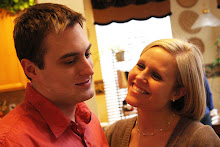A Christmas Note from last year...
So it’s about time for Christmas…….and hopefully we’re all fairly excited! I know I am. I can’t wait to see my family. I mean, who’s been harassing my sisters the past months? Their husbands? Probably. (I know those are fragmented sentences. It’s for style.)
So I can’t recall if I’ve posted this before (big shocker to those of you who know me) but a few months ago, while I was teaching my students about the life of Jesus. I took some time, a few hours really, to study his birth. There are things that we get wrong with the Christmas story that we do know….Mary is never mentioned riding a donkey, the number of Wise men isn’t know and they weren’t there at the time of his birth, etc. But I found something out that to me was even more startling. So in the words of Kevin in Home Alone, “This is it. Don’t get scared now.”
Firstly, we should realize that the gospels do not say that Mary went into labor immediately or after a short period of time after she and Joseph arrived in Bethlehem. Instead Jesus’ birth occurred simply, “while they were there.”
In Luke 2:7 we read, “and she gave birth to her firstborn, a son. She wrapped him in cloths and placed him in a manger, because there was no room for them in the inn.” Now, as it turns out the word for inn, kataluma, can be translated guest room, house or inn. Bethlehem was a very small town, and most commercial inns would be found in major towns with major roads. When Luke wants to refer to one of these inns, he uses the proper term for it, pandacheion. When kataluma is used in both Luke and Mark, it clearly refers to a “guest room” (Mk. 14:14; Lk. 22:11).
How could Jesus be born in a manger in a guest room? Well, the answer is the design of Ancient Near Eastern homes. Often times, the manger was located within the house itself. The home consisted of one large room in which the family would sleep on the upper level and the animals would sleep on a lower level. This was done to prevent theft, most likely (Mom, “Hey Jacob, your room looks like a pig’s sty.” Jacob, “It is.”).
So the most accurate portrayal of the Christmas story according to the sources is this. Mary and Joseph go to Bethlehem and stay at a house crowded with friends or family. Sometime after they arrive there, Mary gives birth (with a lot of people around to help) and they lay Jesus in a manger because it is the most convenient place. The guest room is super crowded. And newborn babies as well as new mom’s are tired, cranky, and so forth.
So what’s the point? Well, to me this view of the Christmas story takes out a lot of the drama on the one hand. But on the other hand it doesn’t. It places it solely where it belongs, upon the baby and coming of Jesus.
I was talking to my youth kids at our Christmas party the other night. Since they already knew this aspect of the story of Christ’s birth from our previous discussions, I focused instead on something that I had never quite understood. (If you’re not bored by this point, then feel free to read some more!)
In birth, and in Mary’s birth, women suffer pain and even injury or death because of the stain of sin (Gen.3:16). But at the end of the birth process, joy and new life have come. Often times, this joy is said to overcome the very pain that the woman is feeling at that time.
Fast forward around thirty-something years and now we have Jesus on a cross, going through pain, to produce new life for all. And after his death, there are tombs being shattered and bodies being raised to life (Mt. 27:52).
At Christmas we celebrate Christ, and by his birth we see the gospel. We see the gospel that covered all of his life, and covers it still. And it is the gospel that covers our lives as well, whether in birth, suffering, or death, until we are raised upon his return.
That’s all I’ve got. Merry Christ……..mas.
Bird Flight Automaton
2 years ago
